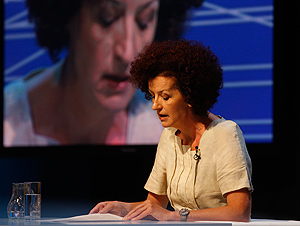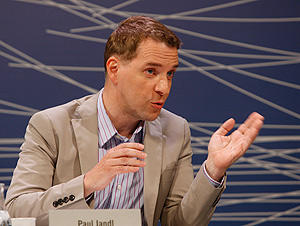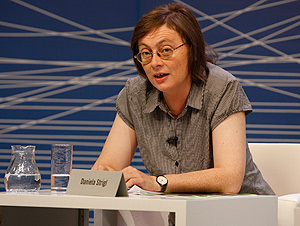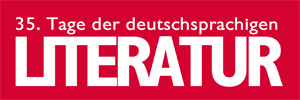 Maja Haderlap (A) Jurydiskussion
Maja Haderlap (A) Jurydiskussion
Maja Haderlap (A) Jury discussion
The bilingual author (Slovenian/German) Maja Haderlap creates the metaphor of a forest for the history of the Kärnten Slowenians and its partisans. The jury was impressed.
 Maja Haderlap (Bild: Johannes Puch)
Maja Haderlap (Bild: Johannes Puch)
Video portrait
Reading
Discussion
Memories of the war
Haderlap's autobiographical text tells of life in the trenches in Eisenkappel from the perspective of a Kärnten Slovenian. The war is long since over but the memory of the life of refuge and deadly danger led by the partisans in the forest still remains with the survivors. There was a prolonged applause for this author and the jury was more than satisfied, even though the very last sentence lled to discussions.
 Hildegard E. Keller (Bild: Johannes Puch)
Hildegard E. Keller (Bild: Johannes Puch)
Keller: "leisurely pace"
"The text which follows a father and daughter through the forest is at an incredibly slow, leisurely pace", began Hildegard E. Keller. Haderlap's text is unpretentious and impressive, but go a little deeper: the little forest outside the front door opens out to a larger world - an individual story within world history.
 Paul Jandl (Bild: Johannes Puch)
Paul Jandl (Bild: Johannes Puch)
Sulzer: "flawless nostalgia"
Alein Claude Sulzer joined the enthusiasm: a flawless, nostalgic text showing great fluency and opening with a superb metaphor The landscape opens up the girl's soul as the conflicts lie in the past. The childlike entrance into "Dachau" evokes a "beautiful" feeling which particularly appealed to him.
Jandl: "subtle language nuances"
"There are three layers to the story" says Paul Jandl: the partisan battle, the life of the girl through the 60's and 70's and finally the level of the storytelling. ""Biographical cross-references" towards Peter Handke's text "Immer noch Sturm" are notable, said Jandl, who however also praised the text's "subtle language nuances". The landscape in question is still charged with history, which is clearly seen in the conflict over the place name sign. An autobiographical text, said Jandl.
 Meike Feßmann (Bild: Johannes Puch)
Meike Feßmann (Bild: Johannes Puch)
Feßmann: "Handke handled the topic better"
Out of respect for the subject, Meike Feßmann paid tribute to the text, and saw this differently than her colleagues' "significantly deeper" view. As mentioned by Sulzer, the reference to "Dachau" is precisely where the weakness of the child-like narration lies. Peter Handke had already handled the topic better and on an "entirely different level"- a "personal archive" has been opened here.
 Daniela Striegl (Bild: Johannes Puch)
Daniela Striegl (Bild: Johannes Puch)
Strigl: "Don't play Handke and Haderlap against each other"
Strigl intervened: to play Handke and Haderlap against each other is "absurd". Here there is an entirely different language at work, the language of a child does not follows the rules of journalism (keyword: Dachau). "A magnificent historical space" is opened up by the forest and simultaneously grows over everything.
This "deeply-based" story is from an archaic and female-dominated world where the father cannot be relied upon. It is hardly known that Austria's resistance movement was supported by the Slovenians. which makes Haderlaps text also extremely important outside of literature. "A nice side-effect ", said Strigl.
Criticism of the final sentence
Meike Feßmann as well as Hubert Winkels and Burkhard Spinnen made objections. Winkels said, even if he liked the text there were some parts with which he could not agree. The final sentence on death was "very poor", since nothing should "justify" death.
Burkhard Spinnen emphasized his respect for the individual story, but reminded the audience that all the children in the 50s and 60s had "damaged" parents. The death at the end effected him like a "lead-balloon" - this atrocity at the end must be compensated by the text later.
 Hubert Winkels (Bild: Johannes Puch)
Hubert Winkels (Bild: Johannes Puch)
Strigl explained: "The death is brought closer because of the stories. This seems plausible when the murder happened virtually on the doorstep.
Jandl added:"History is a continuum." The landscape described here is highly charged, even today.
Barbara Johanna Frank
 TDDL 2011
TDDL 2011